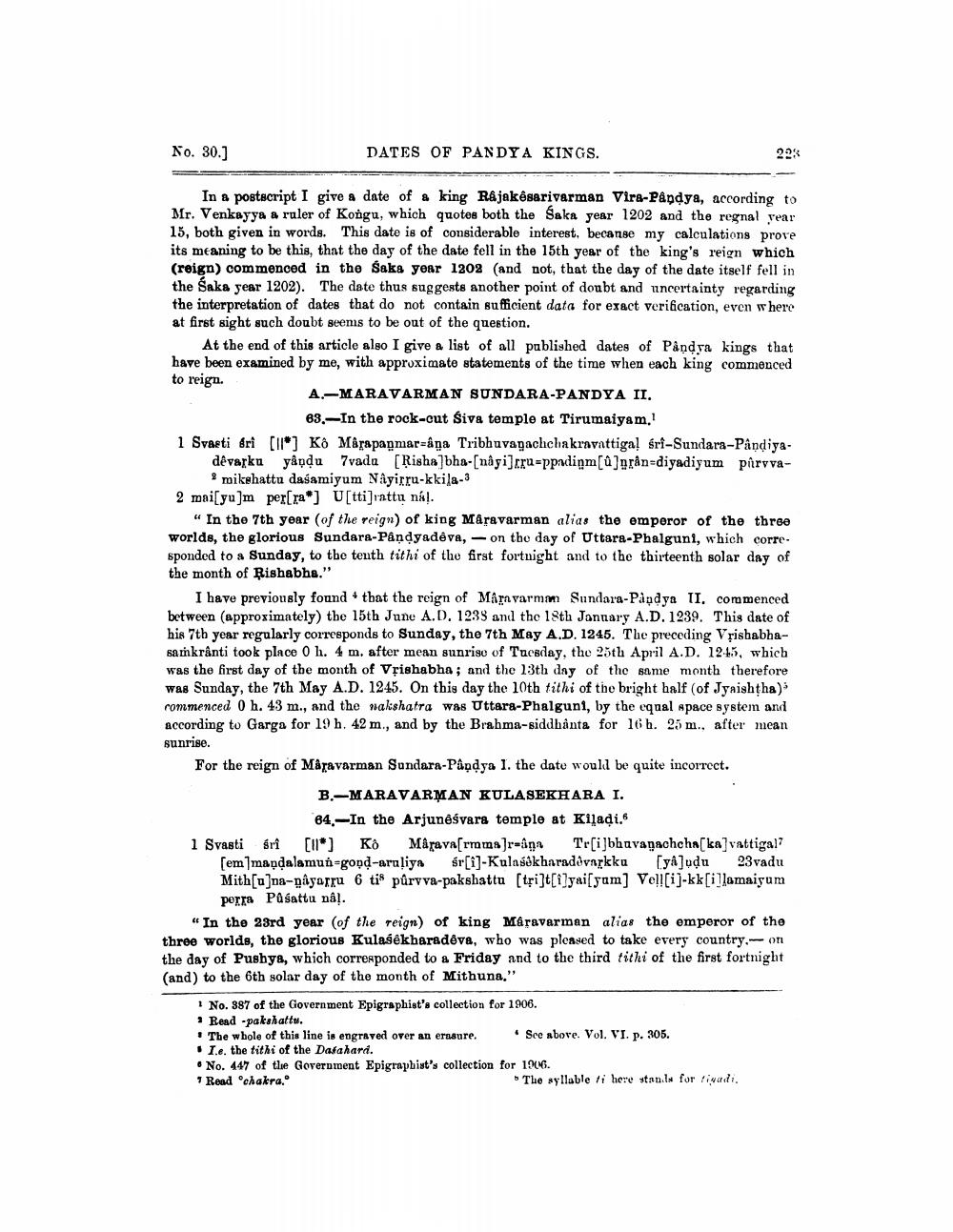________________
No. 30.)
DATES OF PANDYA KINGS.
223
In a postscript I give a date of a king Rajakesarivarman Vira-Pandya, according to Mr. Venkayya a ruler of Kongu, which quotes both the Saka year 1202 and the regnal year 15, both given in words. This date is of considerable interest, becange my calculations prore its meaning to be this, that the day of the date fell in the 15th year of the king's reign which (reign) commenced in the Saka year 1302 (and not, that the day of the date itself fell in the Saka year 1202). The date thus suggests another point of doubt and uncertainty regarding the interpretation of dates that do not contain sufficient data for exact verification, even where at first sight such doubt seems to be out of the question,
At the end of this article algo I give a list of all pablished dates of Påndya kings that have been examined by me, with approximate statements of the time when each king commenced to reign.
A.-MARAVARMAN SUNDARA-PANDYA II.
63.-In the rock-cut Siva temple at Tirumaiyam. 1 Svarti Sri [ll] Kô Mârapaạmar=âņa Tribhuvagachchakravattiga! sri-Sundara-Pandiya
dêvarku yåņdu 7vada [Risha]bha-[nagi]rru-ppadiņm[a]grân-diyadiyum pîrvva
2 mikehatta daśamiyum Nâyirru-kkila-3 2 mai[yu]m per[ra*] U[tti]rattu nál.
“In the 7th year (of the reign of king Mâravarman alias the emperor of the three worlds, the glorious Sundara-Pandyadêva, - on the day of Uttara-Phalguni, which corresponded to a Sunday, to the tenth tithi of the first fortnight and to the thirteenth solar day of the month of Rishabha."
I have previously found that the reign of Maravarman Sundara-Påądya II, commenced between (approximately) the 15th June A.D. 1239 and the 18th January A.D. 1239. This date of his 7th year regularly corresponds to Sunday, the 7th May A.D. 1245. The preceding Vrishabhasankranti took place 0 h. 4 m. after mean sunrise of Tuesday, the 25th April A.D. 12-13, which was the first day of the month of Vsishabha; and the 13th day of the same month therefore was Sunday, the 7th May A.D. 1245. On this day the 10th tithi of the bright half (of Jyaishtha) commenced 0 h. 43 m., and the nakshatra was Uttara-Phalguni, by the equal space system and according to Garga for 19 h. 42 m., and by the Brahma-siddhanta for 16 h. 25 m., after mean sunrise.
For the reign of Mayavarman Sundara-Pandya I. the date would be quite incorrect.
B.-MARAVARMAN KULASEKHARA I.
84.-In the Arjunėśvara temple at Kiladi. 1 Svasti sri [11*] Kô Mârava[rmmar-aņa Tr[i]bhavaṇachcha[ka]vattigal?
[em]mapdalamun-good-araliya sr[i]-Kulasekharadovnrkku (yaludu 23vadu Mith[o]na-payatru 6 ti purv va-pakshattu (tři]t[i]yai[yam] Ve!![i]-kk[illamaiyum
porta Pasattu nå!. “In the 23rd year of the reign) of king Måravarman alias the emperor of the three worlds, the glorious Kulasekharadeva, who was pleased to take every country on the day of Pushya, which corresponded to a Friday and to the third tithi of the first fortnight (and) to the 6th solar day of the month of Mithuna."
No. 887 of the Government Epigraphist's collection for 1906. Read .pakshattu. + The whole of this line is engraved over an erasure. See above. Vol. VI. p. 305. . 1.e. the tithi of the Dalahard. • No. 447 of the Government Epigraphist's collection for 1906. Read chakra.
The syllable fi here stand for livadi.




